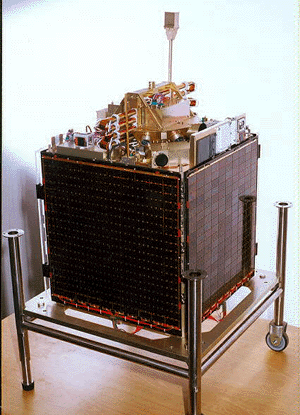
SUNSAT
Jump to: Mission Objectives, Mission Instrumentation, Mission Parameters, Additional Information
Mission Photos:

Courtesy of Stellenbosch University
Mission Objectives:
The Stellenbosch UNiversity SATellite (SUNSAT) is a micro-satellite designed and built by electrical engineering students at the Stellenbosch University in South Africa. This is the first micro-satellite developed in South Africa. Micro-satellites are satellites that weigh between 10-100 kilograms. The primary mission objectives are imaging, world wide store-and-forward email communications, and satellite engineering research. Secondary mission objectives are studies of the earth magnetic field, gravity field, atmosphere, and ionosphere plus intercomparison of GPS and SLR precision orbits.
Mission Instrumentation:
SUNSAT had the following instrumentation onboard:
- Radio amateur communications
- High resolution imager
- Precision attitude control
- Magnetometer
- GPS receiver
- Retroreflector array
- Education experiments
Mission Parameters:
| Sponsor: | Stellenbosch University (South Africa) |
| Expected Life: | 4-5 years |
| Primary Applications: | imaging and email communications |
| Primary Applications: | Precision orbit determination |
| COSPAR ID: | 9900803 |
| SIC Code: | 2301 |
| Satellite Catalog (NORAD) Number: | 25636 |
| Launch Date: | February 23, 1999 |
| RRA Diameter: | 26.4 cm |
| RRA Shape: | annulus |
| Reflectors: | 8 corner cubes |
| Orbit: | sun-synchronous |
| Inclination: | 96.5 degrees |
| Eccentricity: | 0.015 |
| Perigee: | 650 km |
| Period: | 100 minutes |
| Weight: | 60 kg |




